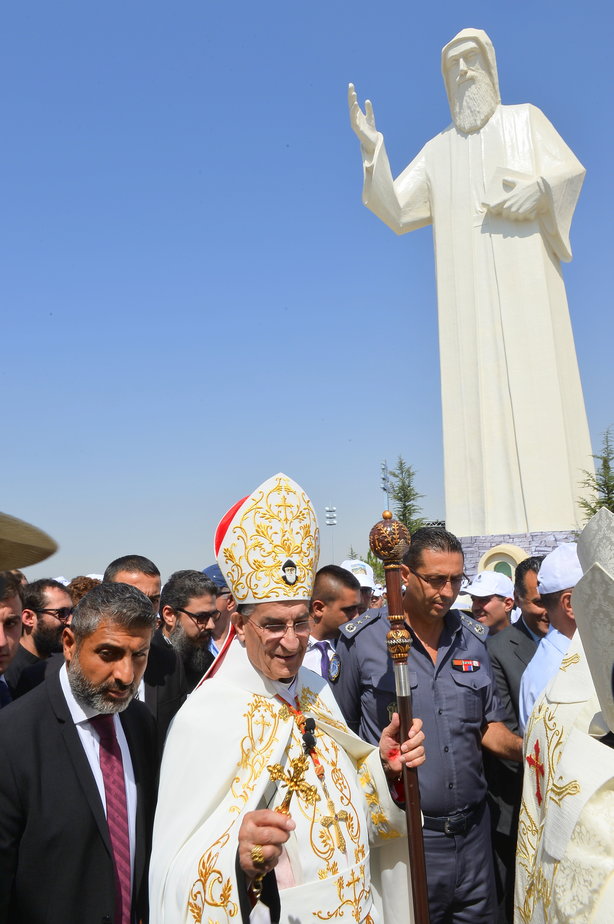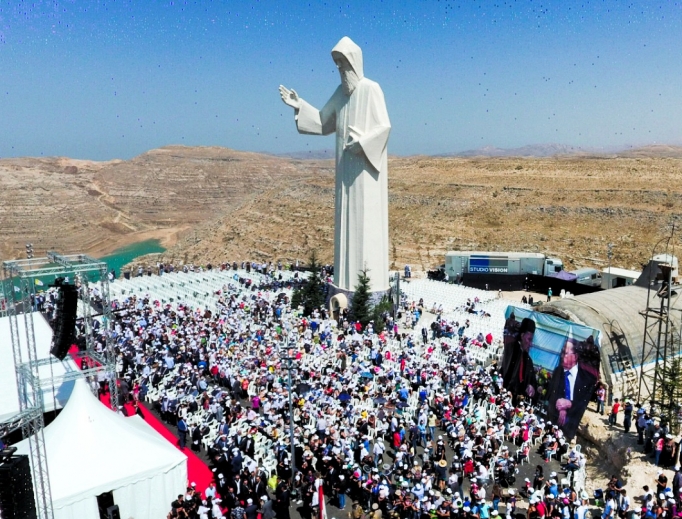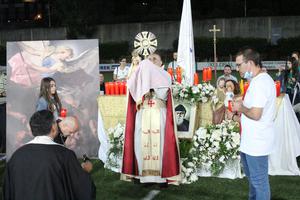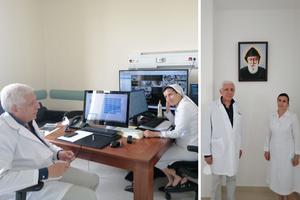Saintly Statue: Lebanon’s Humble St. Charbel Now a Towering Presence
Family donates monument to Maronite hermit in thanksgiving for miraculous healing.

BEIRUT — Lebanon’s beloved St. Charbel now towers high on a mountain in the land of the cedars in the form of the world’s largest statue of the humble hermit.
Located in Faraya, a touristic area popular for skiing 27 miles north of Beirut, the monumental statue is 88.6 feet tall, 30 feet wide and weighs nearly 60 tons.
Lebanese Cardinal Bechara Rai, patriarch of Maronite Catholics, consecrated the statue on the feast of the Exaltation of the Holy Cross, Sept. 14.

St. Charbel was born Joseph Antoun Makhlouf in the northern Lebanese village of Beqa-Kafra in 1828. The youngest of five children, his parents were simple Maronite farmers who were devout in their faith. The world held no interest for the future saint: His yearning was for holiness. Even as a young boy, he would go off alone to a grotto and pray.
At the age of 23, he quietly left his family, traveling more than a day on foot, until he reached Our Lady of Lebanon Monastery, where he began his novitiate. When he joined the order of Lebanese Maronite monks at the Monastery of St. Maron in Annaya, he chose the name Charbel, after a second-century martyr.
Charbel was beatified Dec. 5, 1965, and canonized Oct. 9, 1977 — Lebanon’s first saint. Blessed Pope Paul VI remarked at the beatification ceremony: “What a symbol of union between East and West! ... His whole existence was completely centered on the celebration of Mass, on silent prayer before the Blessed Sacrament and in the heroic practice of the virtues of obedience, poverty and chastity. … May he make us understand, in a world largely fascinated by wealth and comfort, the paramount value of poverty, penance and asceticism, to liberate the soul in its ascent to God.”
The gigantic statue in Faraya represents an expression of gratitude for the healing of a boy through the intercession of the saint in combination with medical treatment.
When 14-year-old Michel Salame first complained of a headache in the summer of 2016, his parents didn’t think it so unusual, as he had been playing soccer and it was a hot day. But Michel’s symptoms quickly deteriorated, and he developed a tumor on his forehead, although not cancerous, and suffered from seizures.
A high-risk surgery was needed, coincidentally on the feast of St. Charbel, with a follow-up surgery a few days later.
Recounting the deep anguish he and his wife experienced, the teenager’s father, Elie Salame, told the Register: “I was praying that maybe the operation wouldn’t be necessary. But St. Charbel sent me a message to go ahead with the second operation.”
Both surgeries were successful, and, as part of his treatment, Michel continued with medication. Now, he is a healthy and thriving 15-year-old. “I can’t say for sure if it is a miracle or not, but for sure, St. Charbel helped us with this huge crisis,” Elie Salame said. The statue was the family’s way of giving thanks for their son’s healing.
Lebanese sculptor Nayef Alwan was commissioned for the monumental statue, with Elie Salame providing the specifications he had in mind. “I just wanted to have it big,” the elder Salame said, “so that it can be seen from all over when it’s lit, to protect Lebanon and all Lebanese — all religions.”
The gigantic St. Charbel statue is Alwan’s first work in fiberglass and resin — so that it would be durable to withstand wind, rain and snow in Faraya, at 6,070 feet above sea level.
Alwan carved the original from cement and clay. It was then fitted with a mold and constructed at a marine industry company by a team of some 60 people, comprised of Christian, Druze and Muslim workers.
When the completed statue was transported, a popular song to the saint, broadcast from a convoy, heralded its passage. The journey from the Mediterranean coast to Faraya took 17 and a half hours.
“It was a big challenge,” Alwan says of the yearlong project. “But it was for St. Charbel, so you just make the Sign of the Cross and go forward and don’t have to worry about anything. I felt it very easy,” he explained.
The 53-year-old Maronite sculptor has created more than 50 statues of St. Charbel, including figures in Australia and Venezuela. At St. Maron’s Monastery in Annaya, where the tomb and hermitage of St. Charbel are located, there are four statues of the saint sculpted by Alwan. The first was created in 1985; the statue, just over three-feet tall, is situated close to the tabernacle in the hermitage.
As with any holy statue he creates, Alwan said, “I must always begin in prayer. When I’m working, I’m praying.”
How does Alwan envision the saint? “Always with a peaceful face, a very holy face. That’s St. Charbel,” the sculptor said. Describing the future saint, one of Father Charbel’s fellow monks wrote: “As he prayed, a heavenly light actually wrapped itself around his face.”
In 1898, Father Charbel was struck by hemiplegia (paralysis on one side of the body) while celebrating Mass. He died eight days later, on Christmas Eve, at the age of 70.
A dazzling light soon appeared around Father Charbel’s tomb. When it was opened four months later, the hermit’s body was incorrupt, secreting blood and sweat. His body continued to bleed for many years, and at times the substance even oozed from the walls of his tomb.
The humble hermit who knew only how to pray, to keep silent, to obey and to do penance, became known all over the world. By 1952, St. Maron’s Monastery had received 130,000 letters from 95 nations, some asking for anything that had come in contact with the holy monk, and with others expressing gratitude for favors received.
According to St. Maron’s Monastery, from the beginning of St. Charbel’s miracles, there have been around 26,000 documented miracles in the monastery’s archive. Each year, St. Charbel is responsible for around 100 miracles, at least 10% of which the recipients are non-baptized individuals, including Muslims, Druze, Jews and atheists.
The Salame family’s zeal of gratitude also took them on pilgrimages to various holy sites to give thanks for Michel’s healing: the Vatican, Lourdes and Fatima, as well as Cassia, Italy, where a 20-foot statue of St. Rita, also created by the Lebanese sculptor Alwan, was erected in 2015 after being blessed by Pope Francis.
During the Prayers of the Faithful at the Mass for the consecration of the St. Charbel statue, Michel Salame, speaking in Italian, then French and Arabic, said, “Dear Lord, we always pray for what we want, and you always give us what we need. There are no words to describe my gratitude. You turned Lebanon into a bouquet of saints that we are smelling every day. Every time we call on them, they fill us up with their grace. For St. Charbel, the prince of all Lebanese saints, to you I offer my silence, since I’m speechless. But I offer you my joy and my appreciation till the day I die. Please keep my country, my Church and my family faithful to you.”

Register correspondent Doreen Abi Raad writes from Beirut, Lebanon.
WATCH:
- Keywords:
- doreen abi raad
- lebanon
- saints
- st. charbel

















